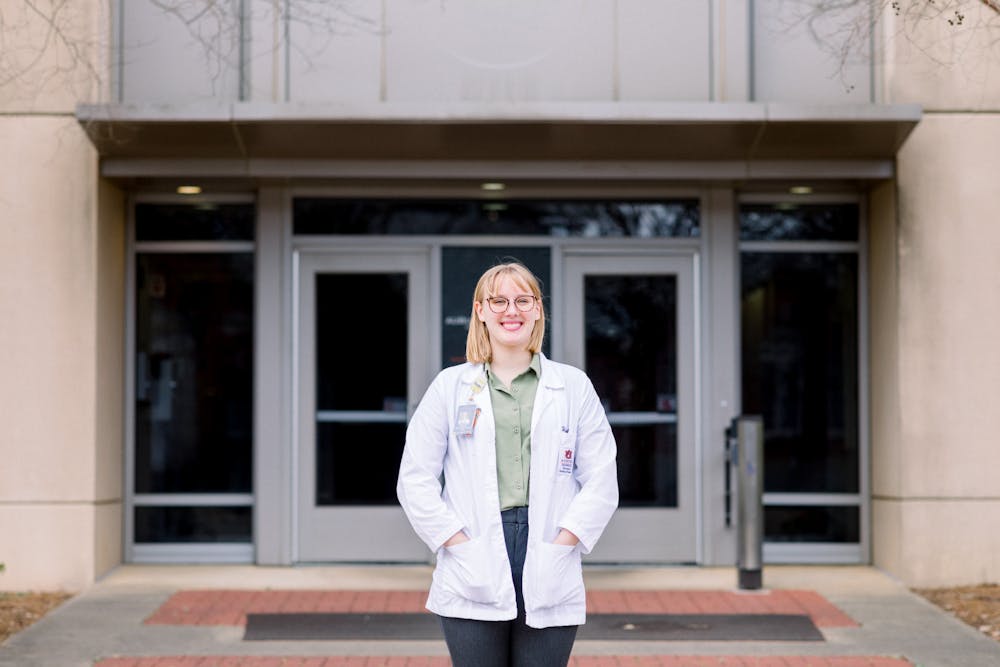Heather Vance, a second-year pharmacy student at Auburn, was volunteering at the free clinic through Equal Access Birmingham like many other students do. It was a Sunday, 7 p.m., and she, a med student from UAB, and their preceptors are seeing the last patient that day.
“They keep mentioning this medication that they’re taking and saying that they don’t feel well when they take it,” Vance said. “So we do this interview with the patient and go back into the counseling room and look at this standard blood pressure medication the patient has been prescribed.”
The patient is taking two times the maximum dose recommended on it.
“I think the doctor was probably like let’s just up your dose, and then doesn’t realize that their dose keeps coming up, and instead they should have just added a second medication,” Vance said. “That’s my favorite like, patient intervention.”
Vance is the president of Equal Access Auburn, which began five or six years ago in collaboration with Equal Access Birmingham. Both organizations’ missions are to provide accessible healthcare options to underserved and insured populations in their surrounding areas.
Unlike EAA, EAB has a free clinic where med students serve patients twice a week, offering full-service health care.
However, EAA students volunteer at the clinic on the Wednesdays and Sundays they’re open and offer their pharmacy advisory services since the clinic doesn’t have a pharmacy on staff.
“We’re really just asking the patient how they’re feeling,” Vance said. “Like our favorite question to ask is what concerns do you have and then they’ll tell us about how they hate their medication. Or that they’ve been feeling bad and we can look at their meds and offer recommendations to the med students. We’ve seen some pretty wacky dosages and prescriptions from some of the prescribers there.”
The pharmacy students are mostly there to help EAB students manage medications so patients can feel good about what’s going on with them,” Vance said.
In addition to volunteering at the EAB clinic, EAA hosts one to two volunteer events a month, alongside community clinic events.
“Sometimes there’s a game on Saturday, so we’ll do a pop-up health fair outside of the pharmacy school,” Vance said. “We have a lot of people who pass by and will stop and do like blood pressure checks, blood sugar, screenings, cholesterol. We also do immunizations, like flu vaccines or polio vaccinations. We’ve had patients tell us that they went to the doctor after and that their doctor agreed with our assessment and they’re managing themselves better.”
When Vance joined EAA and started pharmacy school, she was getting her masters in public health.
“I knew I wanted to be in a pharmacy role that worked in underserved populations or served patients without insurance, just to help increase access to care,” Vance said. “I was looking for organizations that were patient-care focused and had a lot of volunteering opportunities and this was one of the organizations where I could start volunteering right away.”
During her undergraduate education in Wisconsin, she was part of an organization that looked to increase food access in food-insecure areas, which is how she knew she wanted to go the public health route in pharmacy.
“I think as pharmacy students now we’re trying to look for those underserved populations,” Vance said. “Trying to figure out a game plan for them to figure out what’s next, and what they should be doing to receive care. Pharmacists are the experts on medication, but with the pandemic, people have also realized that pharmacists are the most accessible health care providers in the world.”
Vance has worked in retail pharmacy for eight years and has seen a wide range of people walking up to their counter — not only those who are simply looking for the best recommendation for over-the-counter medications.
“Some people will come up to the window to speak to the pharmacist, and show them a rash on their arm and ask what they should do about it,” Vance said. “Being the most accessible health care providers, we’re trying to learn more about the disease states, like learning about signs and symptoms of high blood pressure. Not only how to manage it with medications, but also learning how populations are at risk based on their diet, ethnicity, background, what they do for work, weight or height, so also counseling them on possible lifestyle things.”
According to Vance, Auburn, and other pharmacy schools are adjusting their curriculum in order to reflect this development.
“A lot of programs now focus on making sure you know everything about the meds as a student, and you know how to identify risk factors for disease or somebody comes in,” Vance said. “For example, if someone’s telling you all of their symptoms, you can reorganize if you need to refer them or if you can offer to help them right there.”
Jeanna Sewell, a clinical assistant professor at Auburn, and one of the advisors for EAA, said that the Harrison College of Pharmacy redesigned the curriculum several years ago to make it more practice-ready.
“The purpose is to allow the students to learn in a more integrated fashion,” Sewell said. “They learn the basic science portions of pharmacy all the way to how to I apply this to a patient all within one day or one week. So rather than having separate courses where they talk about the science one year and then apply a year later, we’ve integrated it so they can see it all at one time and go start-to-finish in a type of disease state.”
Sewell, an HCOP graduate, said pharmacy school was not like that for her — they learned basic science for two years and application for two years.
“I think that our students are just going to be more confident, and more able to apply information,” Sewell said. “We also try really hard to teach our students how to evaluate literature and assess guidelines. That way, our students aren’t going to just be able to apply what they learned in school, but as medicine changes, as it inevitably will, they can adapt to that and determine what to do next when those changes occur.”
Sewell also practices at an Auburn clinic called Mercy Medical Clinic, the only clinic in Auburn that serves people without insurance, and is the only pharmacist there that regularly provides clinical services.
“I’ve been with Mercy for five and a half years, and a lot of what I do there is managing chronic medical conditions like diabetes and high blood pressure,” Sewell said. “So many of the patients that we see, and many patients in the community don’t get to spend a whole lot of time with their providers, or they only see them every three to six months or maybe once a year. I’m able to step in along with the providers and provide that in-between care and educate patients on their medications and how to use them.”
Sewell’s role at Mercy and the student’s role at EAA and EAB are just like the roles that pharmacists play all over the country in rural areas, like parts of Alabama.
There are large pockets of Alabama where you have to drive hours to get care, and people may not have the roads or conditions to do that safely.
“But in a lot of these communities, there are pharmacies,” Vance said. “And, as Sewell said, pharmacists can serve in that gap. I had a patient come in and he had a Walmart bag full of his prescriptions, dumped them on the counter, and said “I need all of these filled,” Vance said. “It’s like, ‘Do you know why you’re taking these? Do you know the names of any of them? And he said, no, I’m in between doctors right now, so I need every one of them filled, and I said I’m not going to fill thirty medications. We’re going to take a moment to sit down and talk and see what’s going on.”
Other students are also seeking to increase healthcare access and equity for underserved populations, like third-year pharmacy students Sarah Chirambo, and Melanie Walker-Giles, second-year pharmacy student, the president and president-elect of the Student National Pharmaceutical Association.
SNPhA strives to educate students about and promote active participation in national healthcare issues, with participation in committees focusing on immunization awareness, chronic kidney disease awareness, and an HIV/AIDS awareness initiative.
Both Chirambo and Giles joined the organization and began pursuing pharmacy for many of the same reasons: a passion for helping people.
“I’m really passionate about making sure that people get the health care they need,” Chirambo said. “I’m from Mobile, Alabama, but I was born in Africa. I’ve seen firsthand how health care is when people don’t have access to something they really really need like medication.”
Outside of SNPhA, Chirambo, Giles and other fellow students were awarded a grant from the Alabama Department of Public Health to educate people on why the COVID-19 vaccine is important to get.
“The name of our initiative is called vaxxed to the max, and so starting in March we will be going to different things in Tuskegee,” Giles said. “So we’ll have a table set up that will have pamphlets and brochures to hand out to people and just say, ‘Hey if you have these conditions, this is how COVID can affect you.’”
In March, EAA also partners with the Harrison College of Pharmacy’s American Association of Psychiatric Pharmacists to do a mental health fair, which was held on March 22.
“It will be held 11 to four and it’s going to be upstairs in the student center,” Vance said. “The next community clinic is going to be held April 1 and it’s a collaboration between us and a few other pharmacy school organizations.”
Do you like this story? The Plainsman doesn't accept money from tuition or student fees, and we don't charge a subscription fee. But you can donate to support The Plainsman.

Destini Ambus, senior in journalism, pursuing a minor in sociology is the editor-in-chief of The Auburn Plainsman.





